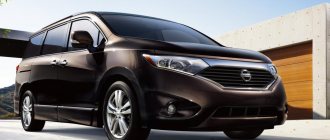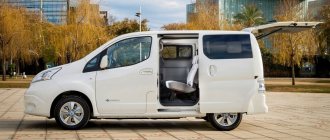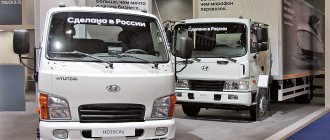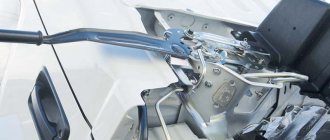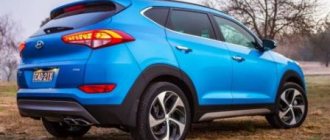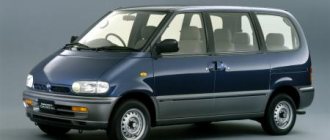Citybus in Japanese
Andrey Filippov, photo by the author
Japan has always followed its own path. This applies to small commercial vehicles, trucks, and buses. And if the first two segments keep up with the times, then with buses everything is a little more complicated. Intercity airliners look quite modern, but city buses seem to be frozen in time, and their “brick” design has now turned into an unshakable monolith, although in terms of aggregate content they can easily compete with Europeans...
Under the J bus brand, both intercity and city cars are produced in Japan using Hino and Isuzu units, respectively. However, in reality there is no strict gradation, and it is almost impossible to visually determine which brand is hidden under the standard body, since when ordering a car they will supply what you need...
Strange passengers
In short, the entire “diversity” of the model range of city cars is represented by the Isuzu Erga model in two wheelbase and length options. The “long” modification is QQG-LV234N3 with a base of 5300 mm and a total length of 10,925 mm, and the “short” modification is QQG-LV234L3, 4800 mm and 10,425 mm, respectively.
Another nuance is related to the build of the Japanese themselves. You guessed correctly - the distance between the seats is relatively small, and the average European rests his knees on the back of the seat in front. And, of course, in the rear of the bus the ceiling puts psychological pressure even on those who are not Gulliver’s height.
However, even taking into account all the nuances, the interior does not seem cramped. After all, 2310 mm is the width and 2325 mm is the height (in the center). And the width of the passage even between the front wheel arches is an acceptable 835 mm.
Ascetic felling
In Japan, as in Europe, it is not customary to separate the driver’s cabin with a solid partition, so, naturally, a separate entrance to the workplace is not provided. Moreover, there is not even protective glass behind the driver’s back – just a regular roll-up curtain, similar to a sunshade.
The workplace itself is also far from modern design trends. A flat panel, square-rectangular drawers on the sides, a scattering of keys, buttons and... toggle switches (in Soviet buses and trolleybuses, these were usually covered with pen caps for ease of use). Moreover, this is exactly a “scattering” - something on the panel, something on the “window sill”, something in the area of the feet, and others high above the head. Chaos, and that's all.
But next to this archaism, a CIRCULAR video surveillance system coexists perfectly. Moreover, the screen does not glare, and the picture is colorful and clear. However, even without it, a system of mirrors, both external and internal, coupled with a light alarm allows you to control almost everything.
I was pleased with the placement of the air ducts in and next to the cabin - it seems that it will not be difficult for the driver to create his own microclimate. However, with a full-fledged air conditioner in the cabin, this may not be necessary.
Alas, there will be no detailed description of the configuration and hardware today. And the point is not even that buses are unlikely to ever be supplied to Russia. It’s just that the Japanese, despite their pedantic approach to any matter, were not ready for these Russians to show such a keen interest in their passenger transport. However, the general data of the most interesting Isuzu Erga Hybrid model in the QQG-LV234L3 body is shown in the table. From what is not included in it, I note - an adjustable air suspension with a plus/minus travel of 50 mm from the “zero” position and a kneeling function with a 70 mm travel.
If we talk about personal impressions, the bus did not surprise, but did not disappoint.
We were able to drive both diesel (ecological class is achieved by using AdBlue) and hybrid cars. The engine, even in the diesel version, does not bother you with noise, but the hybrid (that’s why it’s a hybrid) is generally “silent”. It’s not serious to talk about acceleration dynamics on the factory premises, but it can be stated that there were no annoying vibrations either at idle or at high speeds during acceleration or braking. To service the engine, in addition to the usual external hatches, internal hatches are also actively used, and the floor in the stern can generally be dismantled almost completely. Technical characteristics of the Isuzu Erga Hybrid bus (QQG-LV234L3)
| Overall dimensions, mm | 10 425x2490x2965 |
Passenger capacity, persons
| 71 27 |
Engine:
| Isuzu 6HK1-TCC Hybrid 7790 260 at 2400 rpm 761 at 1460 rpm |
Transmission:
| Automatic 6/1 |
| Suspension | Pneumatic, adjustable |
| Brake system | Pneumatic, with ABS and ASR |
| Wheel formula | 4x2 |
| Minimum turning radius, m | 9 |
Well, perhaps the finishing touch. The cars in the photos are from 2011 and 2009. Even with the discount that these are in-plant vehicles, their condition is perfect, and if it weren’t for the VIN plates, I would confidently say that these are brand new cars, fresh from the assembly line. Production culture? Culture of behavior? Rather, all together, but, nevertheless, the fact of safety is obvious. We have something to strive for!
SIMAZ bus on ISUZU NQR90 chassis
2018.02.08
- bus, Simaz, Simaz, NQR90
A joint project of ISUZU RUS JSC and SIMAZ LLC for the production of buses has started.
In July 2022, a memorandum of intent was signed between ISUZU RUS JSC and SIMAZ LLC to produce buses on the ISUZU NQR90 chassis. The first prototype of the new machine was assembled in October, and work began immediately on its testing and certification. At the same time, preparations were underway for serial production of buses, which, according to plans, should be launched in December. To familiarize carriers with the new equipment, several vehicles from the pilot batch will be put into test operation. This will allow transport companies to compare the new product with their existing vehicles on real routes and comprehensively assess operating costs.
The ISUZU NQR90 model was taken as the chassis for the new bus. Its main advantage is a good reserve of carrying capacity, which allows the bus manufacturer to create modifications of buses of different capacities on the same chassis, without overloading the chassis, suspension and power line. One of the advantages is also the pneumatic drive of the brake system - more reliable in difficult operating conditions than a hydraulic one. In addition, on heavy machines, pneumatics are preferable in terms of braking efficiency. In our case we are talking about buses with a gross weight of 9.5 tons. In addition, the door drive mechanisms will be supplied with air from the pneumatic line, therefore, engineers do not need to come up with new circuits and complicate the drive, reducing its reliability. As shown by sea trials of the prototype, the engine produces 190 hp. With. (torque 510 N•m) provides the car with good dynamics when driving in various road conditions. The chassis frame was modified in the process of adapting it to the body of the city version of the bus. In particular, to ensure optimal fit of the body, engineers increased the spars in the rear. For the same purpose, additional crossbars are installed on the sides. It should be noted that over the 7 years of production, the bus body, mounted on a Russian-assembled Japanese chassis, got rid of the weak points identified during operation, and the carriers’ wishes for modifications were fulfilled in full. In a word, the result is a balanced symbiosis of a reliable chassis and a body that has been adjusted to the smallest detail.
The first in the series will include city buses of three trim levels. The most spacious one is designed to carry 53 passengers. Its interior will be equipped with 14 seats. The second configuration carries 46 passengers, 19 of whom are seated in seats. The third configuration has the maximum number of seats - 21, and the total number of passengers is 42. All three configurations are designed taking into account the wishes of carriers, for whom it is important to have buses of various capacities on their routes. This will optimize operating costs and increase the profit of the transport company. The plant plans to produce not only urban modifications, but also an intercity version of the bus. Its creation will require deeper intervention in the body structure. In particular, the body will be modified taking into account the placement of luggage compartments.
The advantage of the new bus over its main competitors is its durable power line, assembled from reliable Japanese units. The service life of the engine, gearbox and drive axle is 1 million kilometers. And with timely maintenance using original consumables, the units will last even longer. The advantage in reliability and endurance also applies to the chassis and suspension, which work well on poor quality roads. When comparing city versions of the new bus with competitors, it is worth emphasizing greater capacity. Thus, a car designed to carry 53 passengers is very close to the middle class. The warranty on buses will be 3 years or 200,000 kilometers, whichever comes first. Prices and sales start date will be announced soon.
- bus, Simaz, Simaz, NQR90
subscribe now
Comments
